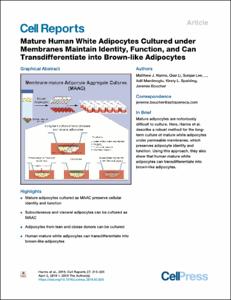GIST Repository
College of Life Sciences and Medical Engineering
Department of Life Sciences
1. Journal Articles
Mature Human White Adipocytes Cultured under Membranes Maintain Identity, Function, and Can Transdifferentiate into Brown-like Adipocytes
- Type
- Article
- Citation
- Cell Reports, v.27, no.1, pp.213 - 225.e5
- Issued Date
- 2019-04
- Abstract
- White adipose tissue (WAT) is a central factor in the development of type 2 diabetes, but there is a paucity of translational models to study mature adipocytes. We describe a method for the culture of mature white adipocytes under a permeable membrane. Compared to existing culture methods, MAAC (membrane mature adipocyte aggregate cultures) better maintain adipogenic gene expression, do not dedifferentiate, display reduced hypoxia, and remain functional after long-term culture. Subcutaneous and visceral adipocytes cultured as MAAC retain depot-specific gene expression, and adipocytes from both lean and obese patients can be cultured. Importantly, we show that rosiglitazone treatment or PGC1 alpha overexpression in mature white adipocytes induces a brown fat transcriptional program, providing direct evidence that human adipocytes can transdifferentiate into brown-like adipocytes. Together, these data show that MAAC are a versatile tool for studying phenotypic changes of mature adipocytes and provide an improved translational model for drug development.
- Publisher
- Cell Press
- ISSN
- 2211-1247
- Appears in Collections:
- Department of Life Sciences > 1. Journal Articles
- 파일 목록
-
-
Download
 Mature Human White Adipocytes Cultured under Membranes Maintain Identity, Function, and Can Transdif.pdf
기타 데이터 / 4.33 MB / Adobe PDF
Mature Human White Adipocytes Cultured under Membranes Maintain Identity, Function, and Can Transdif.pdf
기타 데이터 / 4.33 MB / Adobe PDF
-
Items in Repository are protected by copyright, with all rights reserved, unless otherwise indicated.